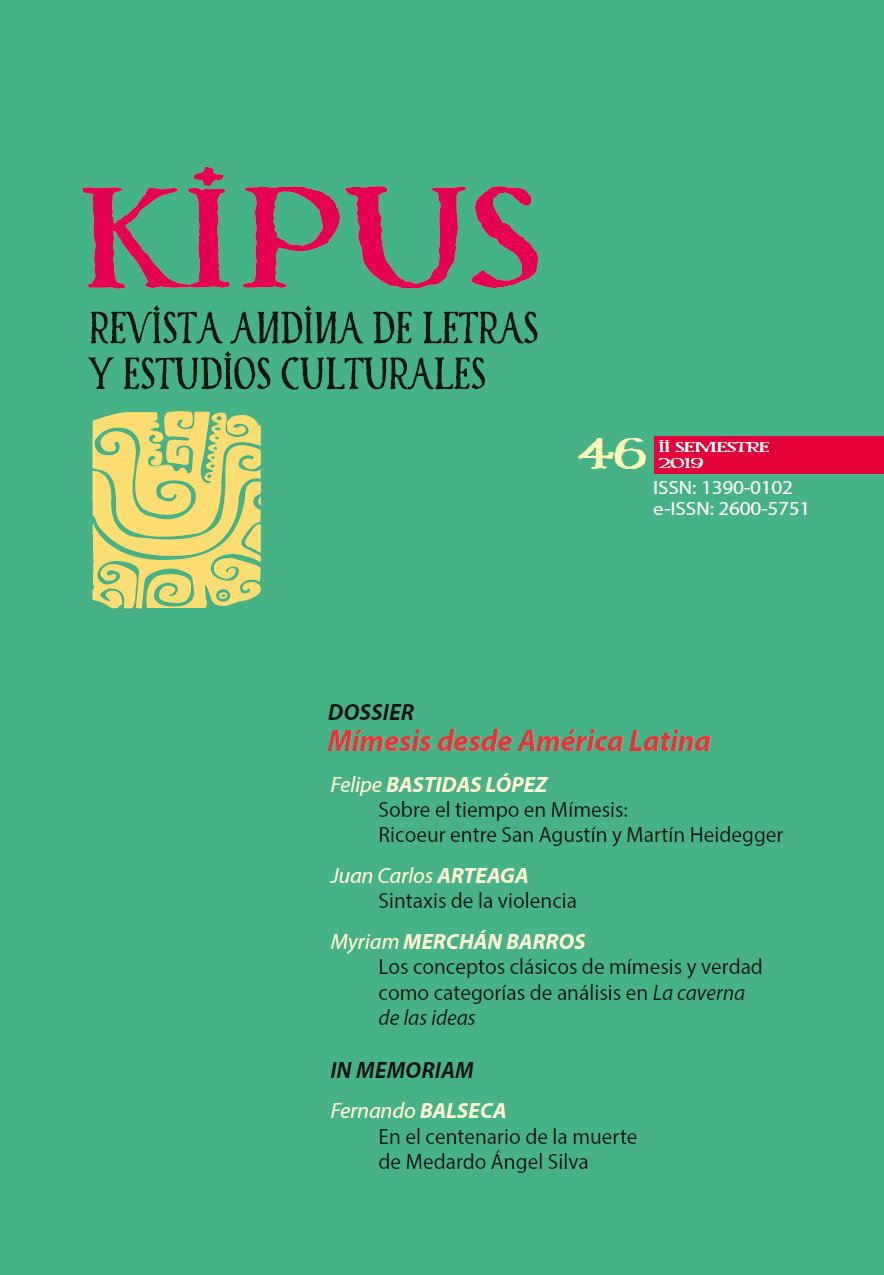The classic concepts of mimesis and truth as categories of analysis in La caverna de las ideas
DOI:
https://doi.org/10.32719/13900102.2019.46.4Keywords:
mímesis, techne, melete, katroptismós, prospoiémata, Platón, knowledge, narratee, reader, traslator, eidesis, aletheia, unveiling, truth, art, José Carlos SomozaAbstract
This article revisits Plato’s concept of mimesis in a rereading of José Carlos Somoza’s text, La caverna de las ideas, from the point of view of the classic referents that have been used to develop the motive of knowledge, analyze the different dimensions of its construction as presented in Plato’s philosophy and how they are recreated in the novel conceptualized as eidesis, a fictional text that contains an enigma as the structuring element of another work of fiction. Emphasis is placed on the cathartic function of art and in the non-exclusive relation between beauty and truth to prove that a rereading of classic works allows us to always distill innovative elements, a challenge, a task that plunges us into an avid reading adventure in search of signification.
Downloads
References
Andriopoulou, Demetrios. 1988. Sense and perception in greek philosophy. Edición griega, Αίσθηση και αντίληψη στην ελληνική φιλοσοφία. Tesalónica: Banias.
Azara, Pedro. 1995. La imagen y el olvido. El arte como engaño en la filosofía de Platón. Barcelona: Siruela.
Benjamin, Walter. 1971. “La tarea del traductor”. En Angelus novus. Barcelona: Edhasa. Andinavirtual. http://andinavirtual.uasb.edu.ec:8080/moodle/mod/folder/view.php?id=20799.
Freire, Raúl Rodríguez. 2012. “Argonautas. La correspondencia entre Erich Auerbach y Walter Benjamin”. Guaraguao. Año 16, n.° 41 (2012): 117-35. Andinavirtual. http://andinavirtual.uasb.edu.ec:8080/moodle/mod/folder/view.php?id=20799.
Gomá Lanzón, Javier. 2005. Imitación y experiencia. Barcelona: Crítica.
Gorri, Antonio Alegre. 1988. Historia de la filosofía antigua. Barcelona: Anthropos.
Grimal, Pierre. 1994. Diccionario de mitología griega y romana. Barcelona: Paidós.
Gutiérrez Canales, Giovanni. 2016. “Sobre el concepto de mímesis en la antigua Grecia”. Bizantion Nea Hellas, n.º 35. Santiago. SciELO. https://scielo.conicyt.cl/scielo.php?script=sci_arttext&pid=S0718-84712016000100005.
Kaufmann, Walter. 1978. Tragedia y filosofía. Barcelona: Seix Barral.
Murdoch, Iris. 1982. El fuego y el sol: Por qué Platón desterró a los artistas. México: Fondo de Cultura Económica.
Platón. 1988. Diálogos IV. República. Introducción, traducción y notas revisadas por Conrado Egger Lanz. Madrid: Gredos.
–––. 1988. Carta VII. Traducciones, introducciones y notas por María de los Ángeles Durán, Francisco Lisi, Juan Zaragoza y Pilar Gómez Cardó. Scribd. https://es.scribd.com/document/226198527/Platon-Carta-Septima-pdf.
–––. 1988. Diálogos V. Traducciones, introducciones y notas por María Isabel Santacruz, Álvaro Vallejo Campos y Néstor Luis Cordero. Madrid: Gredos.
Schamun Vinci, María José. 2003. “La historia única en La caverna de las ideas de José Carlos Somoza”. Revista Hispanista 14, editada por Suely Reis Pinheiro. http://www.hispanista.com.br/revista/artigo123esp.htm.
Somoza, José Carlos. 2000. La caverna de las ideas. Madrid: Santillana.
Tatarkiewicz, Wladyslaw. 2002. Historia de seis ideas. Arte, belleza, forma, creatividad, mímesis, experiencia estética. Madrid: Tecnos.
Watzlawick, Paul. 2005. La realidad inventada. Barcelona: Gedisa.
Downloads
Published
How to Cite
Issue
Section
License

This work is licensed under a Creative Commons Attribution-NonCommercial-ShareAlike 4.0 International License.







.png)
